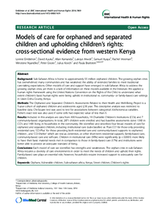The Orphaned and Separated Children’s Assessments Related to their Health and Well-Being Project is a 5-year cohort of orphaned children and adolescents aged ≤18 year. This descriptive analysis was restricted to baseline data. Chi-Square test was used to test for associations between categorical /dichotomous variables. Fisher’s exact test was also used if some cells had expected value of less than 5. The authors applied a human rights framework using the United Nations Convention on the Rights of the Child to understand what extent children’s basic human rights were being upheld in institutional vs. community- or family-based care settings in Uasin Gishu County, Kenya.
Included in this analysis are data from 300 households, 19 Charitable Children’s Institutions (CCIs) and 7 community-based organizations. In total, 2871 children were enrolled and had baseline assessments done: 1390 in CCI’s and 1481 living in households in the community. The authors identified and described four broad models of care for orphaned and separated children, including: institutional care (sub-classified as ‘Pure CCI’ for those only providing residential care, ‘CCI-Plus’ for those providing both residential care and community-based supports to orphaned children , and ‘CCI-Shelter’ which are rescue, detention, or other short-term residential support), family-based care, community-based care and self-care. Children in institutional care (95%) were significantly (p < 0.0001) more likely to have their basic material needs met in comparison to those in family-based care (17%) and institutions were better able to provide an adequate standard of living.
Each model of care the authors identified has strengths and weaknesses. The orphan crisis in sub-Saharan Africa requires a diversity of care environments in order to meet the needs of children and uphold their rights. Family-based care plays an essential role; however, households require increased support to adequately care for children.

